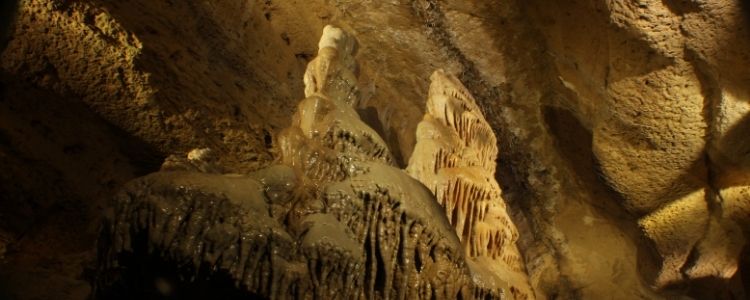Caves & Karst 2023: Science Research Part One
June 2023
Written by Stalac-Tate
June 6th is the International Day of Caves & the Subterranean World. Cave enthusiasts celebrate caves and karst each year to increase awareness of these geologic wonders. Caves are an important part of our planet and should be learned about.
Caves are a great place to learn about the natural environment and human history. Show caves provide answers and awareness to visitors, especially kids. They also are natural laboratories for research of great significance to our world.
Most recently, Dr. Cameron Batchelor published a study about a stalagmite found in Cave of the Mounds. In the research, she found a hidden history of the local climate going back thousands of years. These new findings provide strong evidence that a series of massive and abrupt warming events at the end of the most recent ice age.
This study is the first of its kind to identify a possible link between ice age warm-ups recorded in the Greenland ice sheet and climate records from the last ice age in Cave of the Mounds.
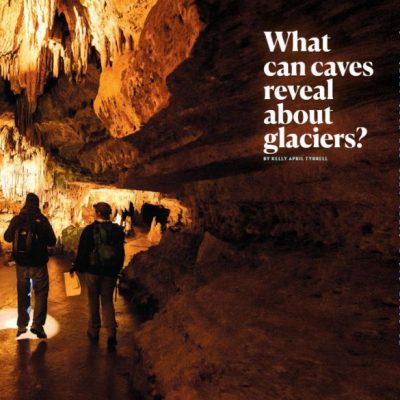

“This is the only study in this area of the world that is recording these abrupt climate events during the last glacial period,” says Cameron Batchelor, who led the analysis while completing her Ph.D. at UW–Madison. Batchelor is now a postdoctoral fellow with the National Science Foundation working at the Massachusetts Institute of Technology.
The stalagmite analyzed grew extremely slowly. It was found that it took roughly 20,000 years to reach the length of a human pinky finger.
“At Cave of the Mounds our mission is to interpret this geologic wonder for our many annual visitors,” says Joe Klimczak, general manager of the cave, which is a designated national natural landmark. “We are thrilled to deepen our understanding of the cave thanks to this world-class research and very exciting results.”
This link is the first of its kind between Central North America and this climate story. Other previous mid-continent research did not have as large temperature swings compared to what was found in the cave research.
“One theory was that the mid-continent is relatively immune to abrupt climate changes and that maybe that’s because it’s surrounded by landmass, and there’s some type of buffering happening,” says Batchelor. “However, when we went and measured, we saw these really large excursions, and we were like, ‘Oh, no, something is definitely happening.’”
This was not the first research study at Cave of the Mounds. In fact, there have been scientists curious about Cave of the Mounds since 1939, just months after its discovery on August 4th, 1939.


First to Study
At the end of October 1939, Dr. J. Harland Bretz, a geologist at the University of Chicago, was the first scientist to study Cave of the Mounds. He was a personal friend of the Brigham family who owned the farm on which the cave is located. Contrary to belief, he was not called immediately after the initial discovery on August 4th. However, he was notified immediately when it was discovered that a cave was beneath the farm.
The weekend before Halloween, October 21st & 22nd, 1939, Dr. Bretz came to Blue Mounds to study and map the cave. During his two-day study, he found several unusual features, particularly interesting to geologists. He also expressed the opinion that the unusual beauty of color, the black and white ribbons in stone, and the abundance of variety of spectacular cave onyx formations warranted making it available to the general public.
Based on that recommendation, the property was leased to Carl P. Brechler and Fred H. Hanneman of Mount Horeb to prep the cave for opening. These two men also secured the services of Alonzo, W. Pond, a well-known explorer and anthropologist, as a manager.
Mr. Charles Brigham Sr., farmer and owner of the cave, had a friend named Robert M. Long. He was an assistant surveyor for Dane County. Using his tools, Robert did survey the cave. Robert was also the one to give Brigham the info on his son-in-law Alonzo Pond because he knew Alonzo would be a good fit.
After reviewing the cave, Alonzo Pond asked if Carl and Mr. Hanneman needed a tour guide. Carl said, “No, but we do need a manager.” A few days later, Alonzo was interviewed and hired as the first manager of Cave of the Mounds.
Cave Pearls
Cave of the Mounds was opened to the public in May 1940. During that first summer open, Larry Burns, a geology student from Beloit College, worked as a guide. While he was there, he delicately examined a section of the cave wall with a flashlight. What he found was in a small cavity called a “vug” in a little bit of water. It was about a dozen cave pearls.
When this was found, he reported it to his mentor and manager, Alonzo Pond. Alonzo Pond was a Beloit Alumni and former curator of the Logan Museum of Anthropology. He loved to be in the field and write all about it.
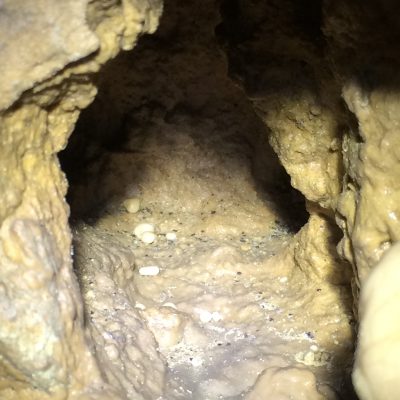

Most of the information that we know today about Cave Oolites is based on an article written by our former manager, famed archaeologist, and writer, Alonzo Pond. He was a manager at the Cave of the Mounds between 1940 and 1945. While he was here, he wrote many articles and papers about a variety of topics. One of which is about our rare, small, hard-to-find “cave pearls”.
In partnership with the University of Wisconsin in Madison, located less than an hour away, Dr. Twenhofel was given one of the cave pearls to study to learn more about this amazing wonder. He cut it in half revealing layers. In the center was a grain of sand with about 14 layers surrounding it.
And we are not the only cave to find these little oolites. Carlsbad Caverns, Cathedral Cavern, and others have found cave pearls in their caves. However, their size and fragility make it hard to share with others as we want to protect them to their fullest extent. The cave will make more and what we have is all that we have. It is part of the cave. It is the pearl of the cave.
Gravity Study of Cave Development
In 1954, Anthony F. Amante conducted a Gravity Study of Cave Development in the Blue Mounds Area. The purpose of the investigation is to ascertain whether subsurface caverns can be located by gravitational measurements.
In 1909, E.G. Lange published a study of the caves in the Blue Mounds Area. Lange described and mapped several caves. Most of these, by 1954 were blocked by rock falls or from having been sealed off as a safety precaution. The origin of the caves is discussed in a study by J. Harlen Bretz of Chicago University.
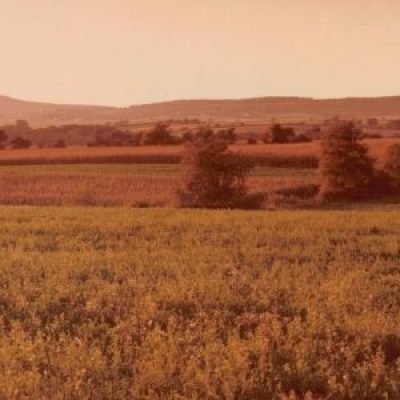

Bretz, in his study on the formation of caverns, concluded that “Cave of the Mounds” has a dal history. It is classified as vadose, meaning it formed above the water table; and phreatic, those that are developed below the water table. The initial erosion below the water table (phreatic) was followed by secondary alteration of the cavities by vadose waters after the subsequent uplift of the region.
A cave is an enclosed mass of air. The density of the air in relation to that of the surrounding rock is extremely small. This contrast in mass will be recorded by the gravity instrument at the surface as a deficiency in mass.
Stations were set in either the immediate vicinity of the cave or in the encompassing area. Intervals were established for the 279 stations. The ones near the cave were at intervals of 25 to 50 feet. The ones within the 1200 ft radius of the known cave were set at 75 to 200 feet. Beyond 1200 feet, the intervals varied from ¼ to ½ mile. This was all done in a 4.5 square mile area around the cave with ⅔ of the stations concentrated over the area of the cave.
Results: Low gravity anomalies in the area
The author noted a long, narrow, vertically walled sink on the northern slope of East Mound. J. Harlen Bretz first observed this. This sink, elongated along the regional dop, appears to be about the same elevation as the known cave. It would suggest a cavern network that extends completely through the mound.
It was not until the late 1990s that these sinkholes were drilled into and examined. At the time, a housing development was being constructed near the location of Cave of the Mounds. To determine if the construction was potentially on unstable rock, a surface impedance study was done and the exploration of Borings was conducted.
In the end, it was determined that although there is some interesting cave exploration still to be done in the area of Cave of the Mounds, the caves should be kept sealed in their natural state for possible future scientific research.
Dripstone and flowstone can form in the same space. The Beauty Rooms are the perfect location to see multiple examples of each. Rimstone dam flowstone on the cave floor, ribbon stalactites so thick they hang like drapery, and tiny soda straws forming delicate colonies in the recessed walls create a masterpiece of natural beauty. There are also thick stalactites and stalagmites that have grown together to create solid columns.
Cave of the Mounds has earned the nickname of the Jewel Box of America’s Show Caves for the variety and delicacy of formations. Observant guests notice the similarities and differences between areas of the cave. They spot the many shapes and colors throughout. What will you notice on your trip underground?
Bacteria & Cave Creatures
In “Ken Christiansen Collenbola Collective” written in 1958, Cave of the Mounds is documented as having the coecobrya tenebricosa in the water of the cave. What is this odd creature? Its common name is a springtail.
Cave of the Mounds has three main cave-adapted organisms; one variety of springtail, and two oxidizing bacteria.
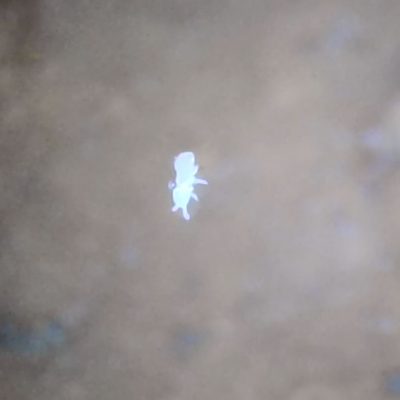

Cave of the Mounds was discovered in 1939 during a routine quarry blast in Blue Mounds, Wisconsin. Before its discovery, there was no sizable entrance to the cave. This means the ecosystem in the cave is exceptionally small; small enough to fit through the cracks in the rock.
Springtails are tiny hexapods often less than 1 mm in length and use a spring (furcula) on their abdomen to “jump” on the surfaces of the pools. Springtails are decomposers and survive on the bacteria in the cave water. These springtails are white and eyeless with long segmented antennae; adaptations for living in dark soil and leaf litter on the surface. These traits are also well suited to living in the total darkness of caves. Approximately 8,000 species of springtails live in caves and soil around the world.
Years later, in 1975, Dr. Douglas E. Caldwell investigated the microbiology of the cave. In the late spring of 1975, the intense coloring of the formations became evident. It was identified that bacteria caused oxidation. Bacteria called LEPTOTHRIX. This bacteria takes ferrous iron, which is dissolved in the water, and use it (the chemical ferrous iron) in their growth process. As bacteria grow and reproduce, they change the ferrous iron to a new form called ferric hydroxide and deposit this insoluble material on the surface of their cell walls. This material does not dissolve in water and thus appears as a crusty, red deposit in the pool. The red material will continue to build within the pool as long as the bacteria grow and multiply.
In the summer of 1975, electron microscope slides have been placed in the pools so that the bacteria will colonize directly on them. After 5-7 days the slides will be removed, taken to the University at Madison to the Bacteriology Department, and observed under the electron microscope. The bacteria will be studied and compared to laboratory-raised organisms.
Dr. Douglas E. Caldwell had come to the cave because it allowed him to study the organisms in their natural habitat – which is always the best place to study them. He also believes that most of the deposited coloring on formations like the Bleeding Stalactites, Petrified Waterfall, etc, may have been of bacterial origin, and would like to check out the possibility.
This means that the coloring on the formations does not come directly from the minerals themselves but from the oxidation through the intervening bacteria.
Leptothrix bacteria can oxidize manganese as a byproduct of metabolizing organic matter; usually expired springtails and other bacteria. The oxidized manganese can be seen on cave formations (speleothems) as a black or gray stain. Leptothrix is found in many aquatic environments and is known to cause clogs in water pipes owing to its manganese and sometimes iron deposits, but it is not known to be harmful to humans.
Gallionella is an iron-oxidizing chemolithotrophic bacteria. This means that by chemically changing (“chemo-”) iron (-litho-) it can gain energy (“-trophic”). Speleothems with Gallionella present can be strained red or have a mineral crust on this oxidized iron. Better known as rust, oxidized iron is also responsible for the color of your blood.
Wisconsin Speleogical Society
In July 1974, Edwin “Mike” Rooney, President of Cave of the Mounds in the late 20th century, was mentioned in the Wisconsin Speleological Society Newsletter. This was the beginning of a beautiful friendship. At this time the WSS was located in Madison, which was fairly close to Blue Mounds. Mike Rooney had requested the start of a dig in what was known as the mud plug at the southern end of the cave. Members of the WSS were Ed Arters, Kevin Hennings, John Henning, George Zachariasen, Joseph Saunders, Dennis Engel, Reginald, Daniel, and more had all participated in the dig.
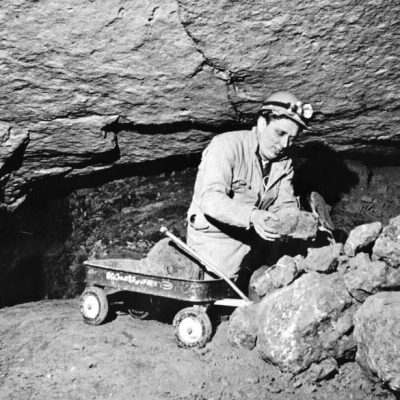

They dug out the loose fill from an inactive sinkhole to see if there was more to the cave. The dirt from the dig was taken from the tunnel and out through the cave gift shop, two flights of stairs, and quite a distance from the south-end blockade. All of this, of course, was done during the winter when the cave is closed to the public. After the digging was completed, a 3-foot tall and 64-foot long tunnel was produced with the confirmation that there was no more to the cave on the southern end.
A few years later, Gary K. Soule, a cave historian, visited the tunnel and noticed rapid deterioration in the wooden roof and wall support beans.
Not long after the tunnel, the WSS mapped Cave of the Mounds. Led by Kevin S. Hennings and Ed Arters, the cave was thoroughly measured, mapped, and handed over to Mr. Rooney. He added the room names and the Cave of the Mounds logo. Then a large quantity was printed and sold to the public for $0.25 each.
The exploration of more caves was something that Mr. Rooney thought to be very important and wanted to try in many ways to pursue the exploration of more caves. Not only was he the one to reach out to the Wisconsin Speleological Society but he also reached out to the Purcell Exploration Service from Texas in 1974. Mr. Rooney corresponded with Paul E. M. Purcell, a geologist, and geophysicist, who advised on how to look for more caves using drills and seismic waves.
What he summed up was that both options have expensive equipment and if done wrong could damage the cave. There needs to be a lot of forethought and research that needs to be done before any of these options. Cave exploration may seem simple at times but because the formations are delicate and are important geologic specimens, the exploration must be taken in a serious matter.
Bristow Method
In 1976, Robert “Bob” Patenaude, a geophysicist and engineer for the Wisconsin Highway Department, contacted Cave of the Mounds to do cavity research using the Bristow method (Pole-dipole technique). This shallow electrical resistivity technique is used while looking for caustic sinks (sink filling) in the parking lot area.
What is happening is a pole is a single transmitting electrode, and a dipole is a pair of oppositely charged electrodes that are so close together that the electric field seems to be a single electrode field instead of fields from two different electric poles.
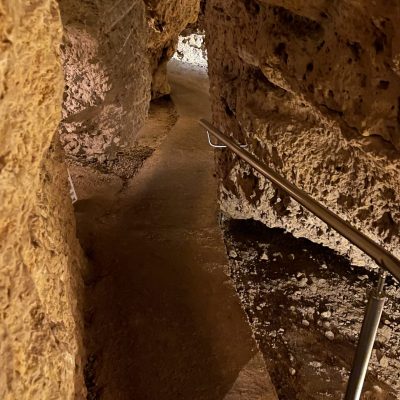


There were 5 series labeled A, B, C, D, and E. The results of these tests could have been better with more power output according to Mr. Patenaude. The Soiltest R-50 meter that was used had a maximum output of 150 milliamps compared to the Keck IC 69 which was used by the U.S. Army Corps of Engineers which has a maximum output of 400 milliamps. With the lower voltage, the measurements beyond 100 feet are less accurate.
In fact, in series A, B, C, and D, the wattage was at 100 milliamps because this was used in the Wenner configuration which was satisfactory. It was not until the first records were plotted that it became apparent that there was a large amount of scatter in the data from distances beyond 80 to 100 feet below the surface. This was when it was decided to use the maximum output of 150 milliamps to improve the quality of data. However, this still left some desired data beyond 150 feet.
The results of these tests resulted in the depth results with the max at 70 to 90 feet deep above the cave. Surface factors like a ravine or metal farm fence made the data lines less conclusive and most scattered. Overall, it did define the ending of the cave being the end of the cave. Some of the results from the prairie across the road let us know that the caves over there are about 50 to 60 feet deep. This does help us later on when a small probe camera was used to see into these closed cave systems. With more amps, there could be a more accurate study to see if there are more caves below the initial Cave of the Mounds. However, because there is no entrance to that area, it would be a fun fact that couldn’t be acted upon for the protection of the cave that already exists.
Graviety Study... Again!
Another method used to see if there is any more cave is the gravity survey. Using a LaCoste-Rumberg meter, a gravity survey was done in 1977. The first round of points was put over the island room, gem room, whisker room, and about ⅓ down Dream River. They formed a straight line. Gravity lines were plotted above and perpendicular to the cave about 150 feet on either side of this main line.
What is happening is a pole is a single transmitting electrode, and a dipole is a pair of oppositely charged electrodes that are so close together that the electric field seems to be a single electrode field instead of fields from two different electric poles.



The outcome of this study did not provide any new information. It did give more accurate measurements of how deep the cave is at a variety of points but there were no new cavities past the ends of the cave. This once again concluded that what has already been explored and what can be seen from the pathway is all of the cave. Despite these results, we still have another 40 years of research to cover!

